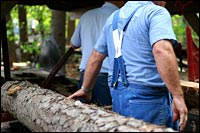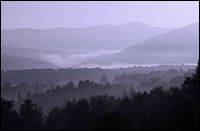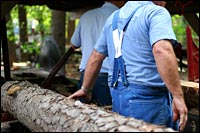Beyond a set of granite gates on a hillside in Rumford, Maine, a lost city sits amid silver maples and oaks, just across the river from a sprawling paper mill.
It’s called Strathglass Park, and it’s a vestige of an experiment in corporate benevolence. Designed in 1904 by noted architect Cass Gilbert, who later designed the Woolworth Building in Manhattan and the U.S. Supreme Court in Washington, this cluster of regal brick homes and boarding houses was built by a paper-company mogul for 266 workers and their families.

Same as it ever was?
Photo: iStockphoto.
The complex offers a glimpse of an almost Oz-like past, when the forest meant prosperity. The pulp and paper mills of New England were far-flung seats of an economic empire — humming with activity, blazing with lights through the night, and spilling money into neighboring communities like drunken lords.
Mill workers were in demand and were paid handsomely. Loggers made a comfortable living. Some companies offered employees loans at favorable rates, built libraries and other public works, and established mutual relief societies to help those in need. Right up into the 1960s and 1970s, mill workers commonly owned lakefront summer homes, which they built on lots leased to them for a pittance by their employers.
That era is past. Today, older mills face mothballing because of tough competition from more modern and efficient facilities overseas, especially in countries where environmental regulations are few. Meanwhile, working in the woods has become ever more mechanized and less labor-intensive — while the output of forest products has remained fairly constant, employment has plunged.
Between 1997 and 2002 in Maine, employment in the forest industry fell by 23 percent, with a loss of more than 5,000 jobs. The prognosis for New England’s outlying counties, which once lived off the fat of the forest, is not favorable: one in four residents in Maine’s Somerset County and one in five in Washington County now live in poverty. Communities at the fringe of New England’s timberlands are fraying.
What’s more, across the region land is being carved up and sold off, which some see as a dagger in the heart of the old economy. Investment trusts and wealthy families have acquired their own fiefdoms — the new owners are locally called “kingdom buyers” — and longtime timberland owners are getting out of the tree business. Nearly one acre in four in Maine has changed hands in the past decade. Nationwide, about 30 million acres, or half the private industrial forestland, has been sold since 1996.
So where does the timberland economy go from here? Increasingly, communities are reclaiming their working woods, with residents and towns banding together to purchase tracts for two purposes: to protect the land and to bolster the local economy. In some cases, the land is set aside specifically for low-income residents. As sustainable forestry advocate David Brynn puts it, “Something interesting is happening in New England.”
This Land Is Our Land
When a 115-acre hillside forest came up for sale in rural western Vermont last year, about 60 potential buyers showed up at three different sales events to learn how they could get a piece of it. The clamor for the land was no surprise — the parcel, on Little Hogback Mountain, is home to stands of lovely red oaks, along with beech and maple, and has a footpath that winds up to a rocky outcropping with valley views. And it came on the market amid a small land rush, with real-estate prices soaring locally, as they have elsewhere in New England.

Whose woods these are we think we know.
Photo: iStockphoto.
What’s surprising about the everyday event is this: those interested parties were exploring the idea of buying the land with others. If all goes as planned, not one but 16 people will end up owning it. Not as individual lots for second homes, but as a communal forest, to be kept undivided and undeveloped. The buyers, each of whom will pay $3,000 for a share, will have access to the land for firewood and recreation. Every 10 to 15 years, a commercial harvest will be carried out, with the proceeds paying forest-management fees and property taxes.
“The democratic approach of chopping the land into tiny pieces so everyone could afford some just wasn’t working,” says Deb Brighton. The area resident and former state conservation official worked with a small group of others — including the Vermont Land Trust and Vermont Family Forests, a nonprofit devoted to keeping timberlands healthy and intact — to arrange the deal. “It was better to manage it as a unit, and to put it into the hands of community members who live and work here, but have less and less opportunity to own land.”
During her stint on Vermont’s Housing and Conservation Board, Brighton realized large tracts of the state’s forestland were increasingly being broken up, and longtime, lower-income residents couldn’t afford to buy and maintain the parcels as productive forestland. Toward that end, half the shares in the Hogback project are reserved for those who earn less than the county’s median household income of $59,000; people in that category are also eligible for a deferred loan to cover half the purchase price. The rest of the shares will be sold to those who have less than twice the median income — in other words, no kingdom buyers need apply.
Brighton and her fellow organizers are currently awaiting a ruling from the IRS to determine how shareholders will be taxed before the project is carried out. But the parcel, currently owned by the Vermont Land Trust, is already contributing to the community. About 6,300 board feet were cut by local loggers last summer, and milled into flooring at mills in Vermont and Quebec. A 40,000 board-feet cut is currently under way on this and other nearby parcels. The flooring bears the Vermont Family Forests name, so buyers know it’s a local product made by local people from a certified, sustainably cut, local forest.
The Hogback deal is just one example of a growing trend. The largest project in the region of late has been the May 2005 purchase of a 27,000-acre community forest by the five-year-old Downeast Lakes Land Trust, in cooperation with the New England Forestry Foundation. The land lies just west of the remote village of Grand Lake Stream, and the buyers are now seeking certification from the Forest Stewardship Council. A 3,560-acre ecological reserve has been set aside within the forest, and 312,000 adjacent acres will be protected by a conservation easement. Hundreds of miles of wild shorefront will be managed for recreation, with the goal of bringing outdoor travelers here to patronize local businesses, including a number of historic sporting lodges. The forest is viewed as an economic engine to keep the community running.
Other acquisitions have included the purchase by Randolph, N.H., of a 10,000-acre forest it feared was destined for development. And late last year, a 5,300-acre community forest known as the 13 Mile Woods was purchased by the town of Errol, N.H., with the assistance of the Trust for Public Land. Rural New England, in effect, has become a laboratory for a series of landscape-sized experiments in building new bridges between forests and their communities.
You Can Get There From Here
“The community forest movement is growing rapidly nationwide,” says Jeffrey Campbell, head of the Ford Foundation’s Community Forestry Initiative. “People are realizing this offers an opportunity for a social and economic benefit.”
“Community forestry” is a one-size-fits-all catchphrase. It’s one thing in Mexico, another in Switzerland, another in Nepal. In the United States, it varies from one coast to the other, and on the lands in between. In the Pacific Northwest, where the federal government owns roughly half the land, the phrase often refers to a process in which loggers, environmentalists, and others come together to craft a vision for the management of public lands.
In the six New England states, which together could fit inside Washington state, only 5 percent of the land is owned by the federal government. Industrial landowners, investment trusts, schools, towns, and states own and manage the rest. So community forestry means something very different in this patchwork of ownerships, and approaches are as varied as the ecosystems and communities from which they spring.
In Vermont, for instance, it’s estimated that about 120 of the state’s 251 municipalities already own a total of 140 forests. These “town forests” are a New England tradition: In the early 20th century, all six states passed laws allowing the establishment of such forests, which were acquired through donation, purchase, or seizure when tax bills went unpaid. Most were set aside for a combination of recreation and forestry.
Few people have paid much attention to these pockets for a half-century or more — local forestry simply fell out of fashion. But that’s been gradually changing, thanks to both rising interest in their economic potential, and — in Vermont — to the Vermont Town Forest Project, a concept that emerged two years ago during a meeting of conservation groups.
Jad Daley, campaign director of the Northern Forest Alliance, heads up the town forest project and said he’s hoping it produces “cross-pollination” — showing how communities with existing town forests can benefit, and encouraging those without to consider acquiring them.

Sweet.
Photo: iStockphoto.
Daley cites tiny Goshen, Vt., by way of example. The town has owned a 1,000-acre forest for the past two decades, and has contracted with area loggers to selectively harvest wood. To date, the forest has yielded more than a quarter-million dollars of revenue, which has been used to fund local road work, among other projects. That, in turn, reduces pressure to raise property taxes. (And sometimes yields other benefits: in the past, a maple-syrup maker provided a half-pint of syrup to each resident in exchange for access to the forest.)
Other communities, such as Stowe, Vt., have concluded that their forests are best managed for recreation, the better to attract tourist dollars. And still others have taken a multi-pronged approach. After a committee of residents in Lincoln, Vt., studied options, they decided to harvest one of their town forests and set a second aside as an ecological reserve.
Daley says the process of debating what to do with a piece of land is often as important as the product: “At the end of the day, the plans are going to be as different as the 251 towns of Vermont.”
Yet they all share a single, powerful notion. “A community forest is broadly defined as [a place] where people get together, either joined by place or by interest, to become involved in how trees are managed for the benefit of all,” says Ajit Krishnaswamy, director of the National Network of Forest Practitioners’ National Community Forestry Center. “And it doesn’t have to be economic; it can involve cultural and social benefits as well.”
“Like communities, no two forest parcels are the same — the history is different, the soil is different,” says Shanna Ratner, a former NCFC staff member who is president of Yellow Wood Associates, which consults with rural communities on economic development. “As people get closer to seeing what’s true — seeing how much you can take out of the forest without damaging it — they see there are all sorts of possibilities.”
Treasure in Them Hills
From an environmental perspective, the hillsides and towns of the old forest economy more resembled Mordor than Oz. Large industrial-scale logging all but strip-mined the forest to feed the mills; the forest fell prey to erosion and monoculture. The paper factories left the rivers caked with scum and increasingly devoid of life. Over the years, much of that damage has been cleaned up. But the mind-set that created it is slower to change.
Brynn, who serves as director of the Green Forestry Education Initiative at the University of Vermont, is also the founder of Vermont Family Forests. He says the organization has been striving to flip an outdated paradigm on its head. The old approach was to develop wood products from the forest, then find a market, then worry about forest health later, if at all. “What we’re trying to do is get people to be aware of forest health first,” Brynn says. “Without healthy forest ecology, there can’t be a healthy forest, or a healthy forest community economy. It’s marketing more of what the forest wants to give.”
Community forest supporters are working to enhance the value of that wood — and working to ensure that the value remains in the community. In 2000, Vermont Family Forests partnered with Middlebury College to provide certified local wood for a $47 million construction project. Architects resisted, since what the local forests offered was less perfect than what they wanted. But eventually the designers came to embrace local material and its imperfections.
Farther south, the New England Forestry Foundation is hoping to help reinvigorate the lagging forest economy in north-central Massachusetts by backing the North Quabbin Woods project, which is striving to bring nine area communities and their landowners together (about 60 percent of the forest is privately owned) to manage the forest sustainably. The program includes training guides for outdoor recreation and operating a two-year-old retail storefront in Orange, Mass., where two dozen artisans and artists showcase products they’ve made from the forest, including burl bowls, cutting boards, cabinets, and other home furnishings.
Other retail shops promoting local forest products have been launched by nonprofits in Farmington, Maine, and Stowe, Vt. It’s a useful first step in highlighting the dependency that exists between town and trees, and showing that local people benefit from local control of the forest. “It’s not how many logs we can take out of the forest, it’s how many dollars we can take out of each log,” Spencer Phillips of The Wilderness Society noted at a community-forestry symposium in Maine last year.
Community forests likely won’t ever be flush enough to underwrite a utopian workers’ paradise. And some of the current efforts — such as developing local markets for local wood — are not happening as quickly as many would like. But never underestimate a powerful idea. Some in the movement compare community forestry to local agriculture. After years of hectoring, the public is slowly and steadily paying attention to where their dinner comes from. Fans of community forestry say the same thing can happen with wood.
“The local message seems to really resonate,” Brynn says. “It’s the whole notion of having a product that comes from a place you know, and you know who the players are. It’s another way of cultivating the human sense of place.”
The Flip Side of Forestry
If community forestry has an evil twin, it might be the brand of internationalized forestry documented earlier this winter by The Sacramento Bee. In a three-part series, the newspaper chronicled the lives — and, in some cases, the deaths — of “Pineros,” Latino foresters, many of whom come to the United States through the federal guest-worker program.
The guest-worker Pineros are in this country legally, but their treatment is often both unlawful and unethical. Over the past decade, forest contractors certified by the U.S. Department of Labor have shorted foreign guest workers out of hundreds of thousands of dollars in wages and violated scores of state and federal laws. Some employers have created a kind of modern-day indentured servitude, charging workers for everything from chainsaws to lodging, and taking away their visas and personal papers.
And tragically, the guest worker program often adds injury to insult — literally. In too many cases, contractors fail to provide adequate training and safety equipment, and workers are discouraged from reporting safety hazards or on-the-job incidents. The Sacramento Bee found that the labor done by guest workers in this industry constitutes one of the most hazardous occupations in America, and one of the most overlooked by state and federal regulators.
The 10,000 or so guest workers in the forestry industry are charged with tending our national commons — but their treatment is a blight on our national conscience. To learn more, read the entire Sacramento Bee series. – Eds.


